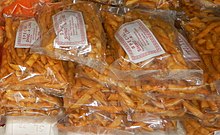
A doughnut or donut is a type of food made from leavened fried dough. It is popular in many countries and is prepared in various forms as a sweet snack that can be homemade or purchased in bakeries, supermarkets, food stalls, and franchised specialty vendors. Doughnut is the traditional spelling, while donut is the simplified version; the terms are used interchangeably.

A fritter is a portion of meat, seafood, fruit, vegetables or other ingredients which have been battered or breaded, or just a portion of dough without further ingredients, that is deep-fried. Fritters are prepared in both sweet and savory varieties.

Chicharrón is a dish generally consisting of fried pork belly or fried pork rinds. Chicharrón may also be made from chicken, mutton or beef.

Filipino cuisine is composed of the cuisines of more than a hundred distinct ethnolinguistic groups found throughout the Philippine archipelago. A majority of mainstream Filipino dishes that compose Filipino cuisine are from the food traditions of various ethnolinguistic groups and tribes of the archipelago, including the Ilocano, Pangasinan, Kapampangan, Tagalog, Bicolano, Visayan, Chavacano and Maranao ethnolinguistic groups. The dishes associated with these groups evolved over the centuries from a largely indigenous base shared with maritime Southeast Asia with varied influences from Chinese, Spanish and American cuisines, in line with the major waves of influence that had enriched the cultures of the archipelago and adapted using indigenous ingredients to meet local preferences.

A rice cake may be any kind of food item made from rice that has been shaped, condensed, or otherwise combined into a single object. A wide variety of rice cakes exist in many different cultures in which rice is eaten and are particularly prevalent in Japan. Common variations include cakes made with rice flour, those made from ground rice, and those made from whole grains of rice compressed together or combined with some other binding substance.

Chicken feet are cooked and eaten in many countries. After an outer layer of hard skin is removed, most of the edible tissue on the feet consists of skin and tendons, with no muscle. This gives the feet a distinct gelatinous texture different from the rest of the chicken meat.
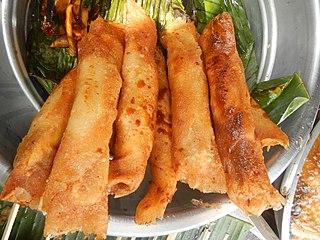
Turon (Tagalog pronunciation: [tuˈɾɔn]; also known as lumpiang saging, is a Philippine snack made of thinly sliced bananas, dusted with brown sugar, rolled in a spring roll wrapper and fried till the wrapper is crisp. Turon can also include other fillings. Most common is jackfruit, but there are also recipes with sweet potato , mango , cheddar cheese and coconut .
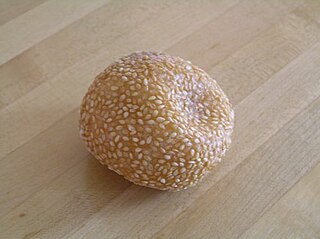
Jiandui are a type of fried Chinese pastry made from glutinous rice flour. The pastry is coated with sesame seeds on the outside and is crisp and chewy after immediately being cooked. Inside the pastry is a large hollow, caused by the expansion of the dough. The hollow of the pastry is filled with a filling usually consisting of lotus paste, or alternatively, sweet black bean paste, or red bean paste. They are also sometimes referred to as sesame balls.

A banana fritter is a fritter made by deep frying battered banana or plantain in hot oil. It is a common dish across Southeast Asia and South India.
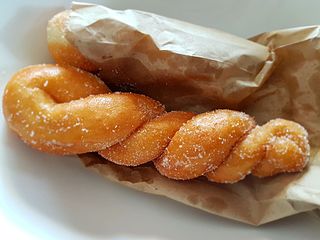
Shakoy, also known as lubid-lubid, is a traditional Filipino deep-fried twisted doughnut. It is traditionally made with flour, sugar, salt, and yeast and deep-fried. It is then sprinkled with white sugar. Variants of shakoy can also be made with other kinds of flour, most notably with rice flour, which results in a chewier version that is also usually coated with sesame seeds. Dry and crunchy versions of shakoy, which are usually much smaller, are known as pilipit.

Lumpia are various types of spring rolls commonly found in Indonesia and the Philippines. Lumpia are made of thin paper-like or crepe-like pastry skin called "lumpia wrapper" enveloping savory or sweet fillings. It is often served as an appetizer or snack, and might be served deep-fried or fresh (unfried). Lumpia are Indonesian and Filipino adaptations of the Fujianese rùnbǐng and Teochew popiah, usually consumed during Qingming Festival.
Lokot-lokot or Locot-locot is a delicacy common in Mindanao and the Sulu Archipelago in the Philippines. It is also referred to as jaa in Sulu; tagaktak, tinagtag, tinadtag, or tinagaktak in Maguindanao, and amik in Davao del Sur. Its texture is crunchy, usually colored golden-brown. Lokot-Lokot is usually produced and served on special occasions such as the Muslim feast of Eid al-Fitr.
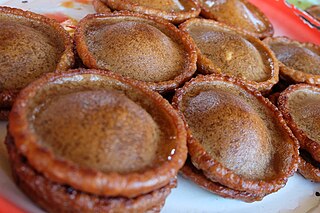
Panyalam or panyam, is a traditional Filipino-Bangsamoro fried rice pancake. It is made with ground glutinous rice, muscovado, and coconut milk mixed into a batter that is deep-fried.

Okoy or ukoy, are Filipino crispy deep-fried fritters made with glutinous rice batter, unshelled small shrimp, and various vegetables, including calabaza, sweet potato, cassava, mung bean sprouts, scallions and julienned carrots, onions, and green papaya. They are traditionally served with vinegar-based dipping sauces. They are eaten on their own or with white rice. They are popular for breakfast, snacks, or appetizers. Okoy are sometimes dyed bright orange with achuete seeds.

Lumpiang gulay, also known as vegetable lumpia, is a Filipino appetizer consisting of julienned or cubed vegetables with ground meat or shrimp in a thin egg crêpe that is deep-fried. A notable variant of lumpiang gulay is lumpiang togue, which is made mostly with togue. Its origin is of both Spanish and Chinese influenced. Lumpiang gulay is a Filipino version of chimichanga.
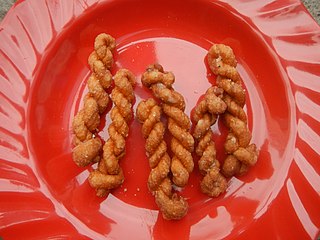
Pilipit is a traditional Filipino deep-fried twisted doughnut. It is made with flour, eggs, milk, salt, and baking powder. It is made mostly identically to the shakoy doughnut, except for its crunchy and hard texture and its smaller and thinner size. The word pilipit means "twisted" in Tagalog.
Kumukunsi is a traditional Filipino deep-fried doughnut originating from the Maguindanao people. It is made from rice flour, duck eggs, and sugar. It is traditionally fried into spiral shapes. It has a creamy flavor, similar to pancakes.

Burmese fritters are traditional fritters consisting of vegetables or seafood that have been battered and deep-fried. Assorted fritters are called a-kyaw-sone. Burmese fritters are generally savory, and often use beans and pulses, similar to South Asian vada.
